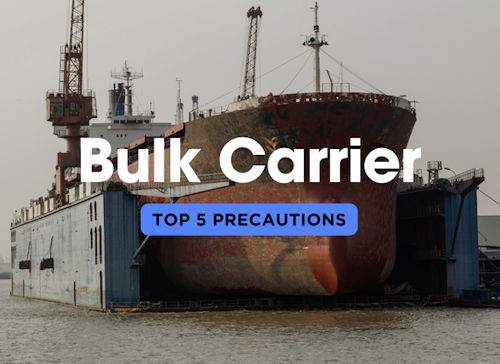
Purchasing a bulk carrier is a complex decision that demands careful scrutiny and detailed knowledge of the vessel’s specifications, condition, and operational history. Bulk carriers, designed to transport large quantities of unpackaged cargo such as coal, grain, ore, and cement, present unique challenges that can significantly impact their operational efficiency and safety. To ensure a sound investment, prospective buyers must consider several critical factors. Below are some specific precautions to take when considering the acquisition of a bulk carrier.
1. Structural Integrity and Hull Condition
The structural integrity of a bulk carrier is paramount, given the immense stresses these vessels endure while transporting dense cargoes. Key areas to focus on include:
- Hull Plate Thickness: Check for uniform thickness in the hull plating, especially around critical areas such as the waterline, ballast tanks, and cargo hold boundaries. Utilize ultrasonic thickness gauging to identify thinning areas that may require immediate repair or replacement.
- Ballast Tank Condition: Inspect the ballast tanks for signs of corrosion, which can compromise the vessel’s stability. Pay close attention to the tank tops and floors, where saltwater can accelerate corrosion. Anodes should be checked and replaced if they show significant wear.
- Bulkhead and Double Bottom Inspection: Examine the bulkheads and double bottom spaces for any signs of structural weakness or previous repairs. Look for buckling, cracks, or evidence of water ingress, which could indicate underlying issues with the vessel’s structural integrity.
2. Machinery and Equipment Functionality
The machinery and equipment on a bulk carrier are critical to its operation, especially given the demanding nature of bulk cargo transport. Detailed inspections should cover the following:
- Main Engine Condition: The main engine is the heart of the vessel. Assess the engine’s overall condition by reviewing maintenance logs, recent overhauls, and service history. Check for oil leaks, abnormal vibrations, or unusual noises that could indicate underlying mechanical issues. Specific attention should be paid to the condition of the cylinder liners, pistons, and turbochargers.
- Cargo Handling Systems: Bulk carriers rely heavily on their cargo handling systems, including grabs, cranes, and conveyor belts. Inspect the hydraulic systems for leaks and ensure that the crane wires and sheaves are in good condition without signs of excessive wear. Test the operation of these systems to confirm they can handle the maximum load capacity efficiently and safely.
- Ballast Water Management Systems (BWMS): Given the strict regulations on ballast water discharge, ensure that the vessel is equipped with a compliant BWMS. Review the system’s certification, operational logs, and any recent inspections or tests. Verify that the system is capable of handling the specific ballast water volumes the vessel typically manages.
3. Regulatory Compliance and Certification
Ensuring that a bulk carrier complies with international and national maritime regulations is essential for smooth operations and avoiding legal issues. Key aspects to consider include:
- Class Certification: Verify that the vessel has an up-to-date class certificate from a recognized classification society. This certificate confirms that the ship meets essential safety and structural standards. Review the classification society’s latest survey reports and note any outstanding recommendations or conditions of class.
- Environmental Compliance: Check for compliance with environmental regulations, such as the International Maritime Organization’s (IMO) MARPOL Convention. This includes verifying the presence of an approved Ballast Water Management System (BWMS), adherence to sulfur oxide (SOx) emission limits, and proper handling of waste and pollutants. Ensure the vessel has the necessary International Oil Pollution Prevention (IOPP) and International Sewage Pollution Prevention (ISPP) certificates.
- Safety Equipment Certification: Confirm that all safety equipment, including lifeboats, firefighting systems, and emergency alarms, is certified and in good working condition. The ship should have a valid Safety Management Certificate (SMC) and a Document of Compliance (DOC) indicating adherence to the International Safety Management (ISM) Code.
4. Cargo Hold and Hatch Cover Condition
The cargo holds and hatch covers are critical components that directly impact the efficiency and safety of cargo operations. Thorough inspections should include:
- Hatch Cover Sealing and Integrity: Inspect the hatch covers for any signs of damage, corrosion, or misalignment. Proper sealing is crucial to prevent water ingress, which can damage cargo and affect the ship’s stability. Conduct a hose test or ultrasonic test to check for leaks.
- Cargo Hold Coating and Cleanliness: The condition of the cargo hold coatings is vital for preventing corrosion and contamination of cargo. Inspect the coatings for wear, flaking, or rust. A clean, well-maintained cargo hold ensures faster turnaround times and reduces the risk of cargo contamination.
- Ventilation Systems: Evaluate the cargo hold ventilation systems to ensure they are functioning correctly. Proper ventilation is necessary to prevent the buildup of moisture, which can lead to cargo spoilage or damage, particularly when transporting hygroscopic materials like grains.
5. Fuel Efficiency and Operational Costs
Understanding the fuel efficiency and associated operational costs of a bulk carrier is crucial for long-term financial planning. Key considerations include:
- Fuel Consumption Data: Review the vessel’s historical fuel consumption data under various loading conditions and voyage profiles. This data provides insight into the ship’s fuel efficiency and potential operating costs. Consider the fuel type the vessel uses, especially in light of new regulations such as the IMO 2020 sulfur cap.
- Energy-Saving Technologies: Assess the presence and effectiveness of energy-saving technologies such as hull modifications, propeller optimization, or waste heat recovery systems. These features can significantly reduce fuel consumption and lower operating costs.
- Maintenance and Spare Parts Availability: Evaluate the availability and cost of spare parts, especially for the main engine and critical machinery. The frequency and cost of maintenance can impact the overall cost-effectiveness of the vessel. Consider the ship’s age and the likelihood of requiring significant overhauls or upgrades to remain compliant with future regulations.
By thoroughly examining these factors, prospective buyers can make informed decisions and avoid potential pitfalls when purchasing a bulk carrier. The next steps involve assessing the market trends, financing options, and considering the potential for retrofitting or upgrading the vessel to meet future operational and regulatory demands.


